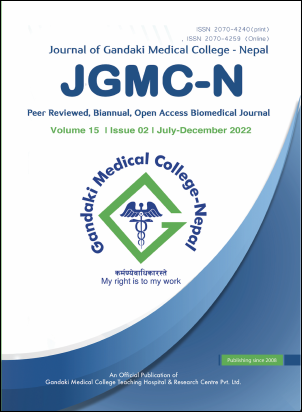Assessment of distribution of clinically undetectable mucogingival junction in mandibular anterior region: A single-institutional study
DOI:
https://doi.org/10.3126/jgmcn.v15i2.49633Keywords:
Attached gingiva, baseline data, gingival recession, mucogingival junctionAbstract
Introduction: The mucogingival junction is considered one of the vital anatomic structures that mark the apical termination of the attached gingiva. However, due to various pathologies and conditions, it can be undetectable. This study aimed to assess the distribution of patients having teeth without clinically detectable mucogingival junction in mandibular anteriors. Various etiologies leading to clinically undetectable mucogingival junction were also identified.
Methods: This cross-sectional study involved 312 patients who visited the department of Periodontics of Gandaki Medical College Teaching Hospital and Research Center, Pokhara from July 26 to November 26, 2022. The visual method, rolling probe method, tension test and histochemical staining were used to detect the mucogingival junction. To ascertain the relationship between age and gender with the distribution of data, descriptive analysis and the Pearson Chi-square test was used. A p-value <0.05 was considered statistically significant.
Results: The majority of the patients 242(77.6%), had clinically detectable mucogingival junction, whereas the remaining 70(22.4%) didn’t show its absence. Gingival recession, keratosis, deep pockets, and aberrant frenal attachment were all common etiologic factors for clinically undetectable mucogingival junction. Statistically significant number of male patients from age group above 45 years presented with clinically undetectable mucogingival junction.
Conclusions: Nearly one-third of the study population presented with clinically undetectable mucogingival junction, which provides baseline data to determine the periodontal health of the study population and can represent as one of the significant diagnostic clues.
Downloads
Downloads
Published
How to Cite
Issue
Section
License
Copyright (c) 2022 Soni Bista, Rebicca Ranjit, Suraksha Subedi, Bijayata Shrestha

This work is licensed under a Creative Commons Attribution-NonCommercial 4.0 International License.
This license allows reusers to distribute, remix, adapt, and build upon the material in any medium or format for noncommercial purposes only, and only so long as attribution is given to the creator.




